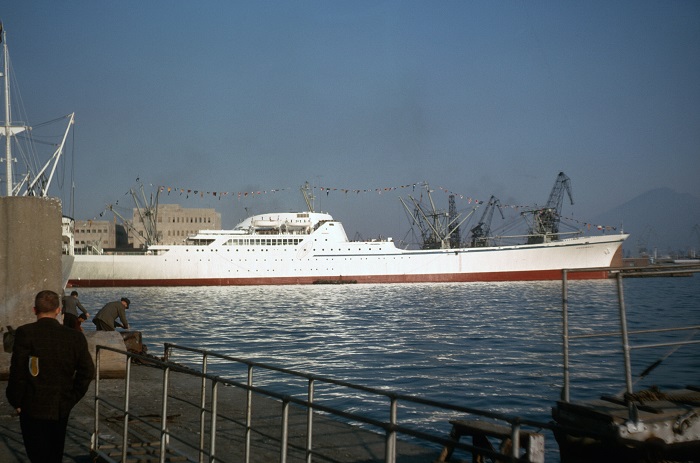Not Anytime Soon

NS SAVANNAH, mid-1960s. Photo taken by crew member Dan Campbell, courtesy NS Savannah Association, Inc.
A statement made this week by the President of Iran has gained some hold on the press, and while it sounds like an interesting and for some potentially threatening development, it more than likely won't happen any time soon.
On Tuesday, December 13, Iranian President Hassan Rouhani publicly announced that he had ordered the development of nuclear propulsion for ships. As an addendum to this new program, Rouhani also wants Iranian scientists to prepare a study on the production of nuclear fuel for such a power plant inside Iran. Rouhani expects reports on the feasibility of both projects three months from the announcement.
Analysts are up in arms over the fact that it is generally believed that maritime propulsion (and it is not yet clear what is to be propelled -- merchant ships, surface warships, submarines) requires very high enrichment of uranium which of course would violate the 3.67 percent enrichment limit placed on Iran by the recent negotiations with the United States. In fact, though, it should be pointed out that during its entire ten-year operational life the U.S. nuclear merchant ship NS SAVANNAH operated with an average core enrichment of only 4.4 percent. The outer / first-pass fuel assemblies in this ship's reactor were enriched to 4.6 percent, while the inner / second-pass fuel assemblies were enriched to 4.2 percent. Although the low-enrichment limit placed on Iran by the treaty makes any potentially useful shipboard reactor larger for its power than might be ideal, or else much shorter lived, it is doable. Further, it's easily possible to design a nuclear plant for a shipboard (or any) installation that will accept higher enrichment and even potentially a significant power uprate later on.
What's important to know, too, is that no Iranian nuclear-powered ship is going to be hitting the water within at least a decade. The well-known U.S. program to develop submarine nuclear propulsion had its first flicker of existence in 1939, but it was not until 1946 that a program got going in earnest. With two parallel projects working to beat each other, a Manhattan Project-derived drive, and the legendary leadership of Admiral Rickover, a working prototype was produced in 1953. This was seven years, give or take, and was the result of a massive expenditure. In contrast, the Indian project to develop a nuclear submarine first came up in 1971, but because of mistakes in design selection a great deal of time and money was lost on a first concept that didn't work out. By the middle 1980's Russian technical help was enlisted and a new project begun. The prototype for the first Indian nuclear sub did not finally reach first criticality until November 11, 2003 although many modifications were required and it was not declared fully operational until September 2006. This is a whole lot longer than the seven years the U.S. nuclear sub prototype took, and probably gives an opposite endpoint in terms of theoretical project time.
It's impossible to imagine the Iranians, given their heavy involvement with Russia in the field of commercial nuclear power, not also attempting to enlist assistance in the development of shipboard nuclear propulsion from the Russians in some shape or form down the line.
Only the passage of time will tell if this Iranian project (which has been announced and cancelled once before) will bear any fruit. It makes sense that Iran would want to develop its own technology. Perhaps it does not want to burn its best commodity (oil) in the ships that transport it, or maybe it seeks a military end use of nuclear ship propulsion. I myself cannot help but believe that this must be part of the program, or perhaps all of it with no commercial use at all. Given the examples above, we can be sure of one thing right now: We have plenty of time to sit around and speculate.

